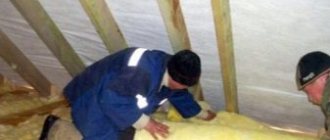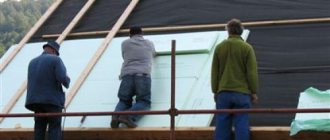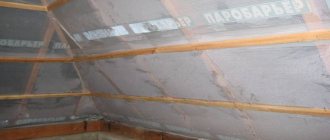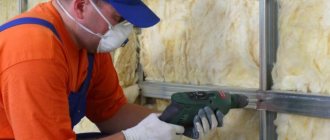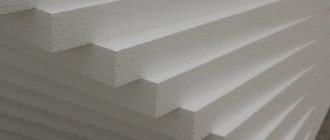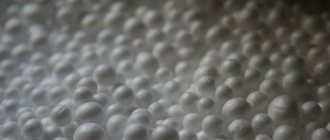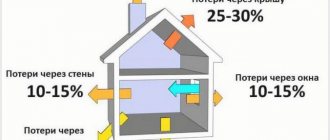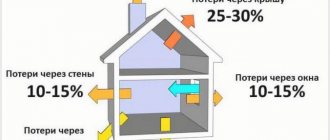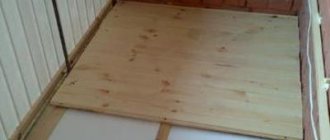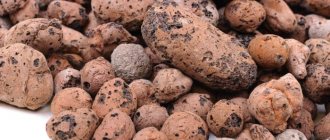There are several ways to figure out how suitable foam materials are for an attic space. For example, use reviews about attic insulation with polystyrene foam. It’s even better if you manage to take part at least once in the process of laying insulation in a residential attic or any other room similar in structure and size to an attic. Once done with your own hands, insulating an attic with penoplex is worth ten reviews, although, from a practical point of view, you can find a lot of rational ideas in them.
Is it possible to insulate an attic from the inside with penoplex?
The problem of using foamed polystyrene or its more rigid and durable form - extruded penoplex has always been associated with the safety of the material. The main obstacle preventing insulation with expanded polystyrene from the inside of the attic, according to reviews from developers, is considered to be:
- The presence in the foamed structure of polystyrene foam of residues of the primary solvent styrene and foam-forming freons, inhalation of which can lead to serious illnesses;
- Flammability of the material. Unlike mineral wool or even polyurethane foam, attic insulation made from polystyrene foam burns very quickly, releasing a huge amount of toxic thermal decomposition products.
It cannot be said that fears regarding the use of polystyrene foam insulation are too exaggerated. According to reviews, few developers really understand the dangers of old polystyrene foam, and that both factors are more relevant to foam plastics and EPS produced using old technology.
Important! The vast majority of modern polystyrene foam manufacturers have long abandoned freon; the residual toluene content in the mass is controlled by technology, and special additives of non-ferrous metal salts are used to reduce flammability.
Moreover, polystyrene foam, intended for insulating the walls of attics, verandas, and rooms of residential buildings, has appropriate markings that are different from technical foam plastic and EPS for communications and road construction. It is with this type of penoplex that you can insulate an attic, without any particular risk to the health of the residents.
Pros and cons of attic insulation with polystyrene foam
It cannot be said that penoplex has completely and completely replaced all competing methods of insulation. According to reviews, along with EPS, craftsmen actively use mineral wool and fiberglass materials, polyurethane foam and granule-based backfills to insulate attics and residential buildings.
Insulating the attic with extruded polystyrene foam makes sense in two cases:
- The house with an attic was built in an area with a fairly humid climate; polystyrene foam insulation, unlike expanded clay and mineral wool, is not afraid of fog and “wet” air, so it can be used even without external cladding;
- A country house or country house with an attic is visited in winter no more than 1-2 times a week. The use of insulation based on polystyrene foam guarantees the safety of thermal insulation under conditions of fluctuating temperatures and humidity.
It is clear that penoplex and lighter foam plastic have disadvantages, which in some cases can outweigh even the positive qualities of the material. In addition to the fact that polystyrene foam insulation can burn in direct contact with the fire front, the material is also quite sensitive to solar ultraviolet radiation. Therefore, when insulating the gables of a dacha with an attic, the heat-insulating layer must be laid only from the inside of the room, or use siding. According to reviews, penoplex on the facade is clearly better than mineral wool.
The main inconvenience in using foamed polystyrene is its almost zero vapor permeability. While polystyrene foam can still somehow transmit water vapor, foam boards are absolutely impermeable to moisture. This dramatically worsens the level of comfort in the room and requires the use of additional supply and exhaust ventilation. According to reviews, it is errors in the insulation device that become the reason for replacing polystyrene foam with mineral wool.
In addition, polymer foam material is easily damaged by rodents, so if there is a threat, the attic insulation must be covered with metal mesh and finishing based on sand-cement plasters.
For your information! Polystyrene foam is easy to cut even with an ordinary knife or thermal cutter, but the dust generated during mechanical processing and cutting of insulation boards is easily electrified and sticks to any surface.
Therefore, when planning work with polystyrene foam or penoplex inside the attic, it is imperative to provide for the removal of dust and scraps, preferably using a vacuum cleaner and exhaust ventilation. According to reviews, you will need a vacuum cleaner and gloves.
Thickness of the insulating layer and the principle of similarity
The attic sandwich includes:
- roofing material (tiles, metal tiles, bitumen roofing);
- waterproofing membrane;
- insulation;
- vapor barrier membrane;
- decorative ceiling decoration.
Schematic diagram of the design of insulating an attic roof with foam plastic
In each specific case, the calculation of the required thickness of roofing thermal insulation is carried out taking into account the climatic zone and the properties of all 5 layers listed above. You can find many options for construction thermal calculators on the Internet. Some of them are presented by companies that produce insulating materials, but we recommend using options developed by independent authors.
Here, for example, is a calculator from ROCKWOOL: https://www.calc.rockwool.ru/
You should be aware that without basic knowledge about building structures and thermal physics, using programs of this kind is almost useless. Therefore, you will have to, at a minimum, become familiar with the law of heat transfer through a flat wall and the role of the main significant parameters - thermal conductivity coefficient λ, layer thickness S and the difference between internal and external temperatures Δt. Otherwise, you may not notice a gross error in the substituted data and continue to be guided by an erroneous calculated value.
Special foam sheets with grooves for rafters.
The calculator does not give a clear way of calculation. The data obtained depends not only on the materials and designs, but also on the desired level of comfort in the room, as well as the heating intensity that you can afford when living in the attic. Therefore, statements like “insulating an attic with foam plastic in central Russia makes sense with a layer thickness of at least 300 mm” or “you need to focus on the cross-sectional height of the rafter beams” do not have much practical significance. However, if, according to the thermal calculation of the attic roof, you get the required foam thickness of less than 150 mm, this with a 99% probability indicates an error, even if the house is located in Krasnodar or Sochi. The same can be said about excessive (more than 350 mm) calculation results.
The principle of physical similarity allows us to simplify the choice of insulator thickness and heating system power. This is possible if you have information about a house with an attic in your region, similar in design to the one in which you will be working.
How to calculate the required insulation thickness in practice
Suppose you know that the sample house is equipped with a 5-layer roofing sandwich with a total thickness of mineral wool of 25 cm as the main insulation. At the same time, the practice of living on this attic floor indicates the sufficiency of insulation. In this case, using the proportion Sмв/λмв = Spп/λп the equivalent value for polystyrene foam is determined:
Sp = (Smv x λp)/λmv = (25×0.034)/0.040 = 21.35 (cm)
As an example, the average values of the thermal conductivity coefficients of various brands of the materials under consideration were taken.
How to choose penoplex for insulating an attic roof
Several types of extruded polystyrene foam are used for construction work. The most famous and affordable is brand “C” penoplex. It is used for exterior finishing of walls without cladding or for insulation of vertical surfaces in non-residential premises. It can be used to insulate the gable walls of the attic. For the interior space of the attic floor “C”, penoplex is usually not used due to the high content of chromium salts. According to reviews, “C” - expanded polystyrene is excellent for floor insulation and sometimes attic ventilation.
In addition to expanded polystyrene “C”, material of grades “A” and “K” is produced. In the first case, “A” - penoplex is used in road construction and foundation insulation. The second - penoplex "K" is used to insulate walls and interior space. Material density 33 kg/m2, heat resistance up to 75°C. The main thing is that pressed polystyrene foam does not have unsafe additives and additives, and the mechanical and heat-insulating qualities, according to reviews, are not inferior to other brands.
It is believed that the insulation layer made of "K" grade polystyrene foam provides reliable protection against water vapor and can be used without a vapor barrier, primarily due to the special edge profile that forms a lock. In practice, craftsmen still prefer to play it safe and lay additional vapor barrier on top of the insulation.
Penoplex thickness for attic insulation
The most popular sheet size is 600x1200 mm. The material fits easily into the gaps between the rafters or frame slats. The thickness of the penoplex in the attic is chosen depending on the profile of the room and the location of the walls relative to the roof slopes.
For habitable attics, in which the walls are formed by rafters and frame sheathing, the insulation thickness is assumed to be maximum - 100 mm for middle latitudes and 150 mm for southern and northern regions.
If the attic is built as a classic room with vertical walls, then for their insulation you can use polystyrene foam with a thickness of 75-100 mm, provided that an uninsulated roof is laid. For a warm attic, the attic walls can be insulated with slabs 50-75 mm thick.
In any case, the insulation of the room must consist of at least two layers to ensure the overlap of seams and possible cold bridges. According to reviews, it is best to glue with polyurethane foam or paint.
Nuances of insulation
As for the attic, the insulation of the walls should not only prevent the penetration of precipitation, but also reliably protect the upper floor from the penetration of heat and cold from the outside. Cold air always sinks down, pushing out warm air, so the temperature in the ceiling area will always be several degrees higher. In any case, heat loss from the wall and roof will differ significantly, even if the thickness of the materials is approximately the same.
Moreover, due to changes in air temperature, condensation may form on the attic ceiling, which can negatively affect the operation of the entire structure. The attic ceiling is more vulnerable than other elements; for example, a certain temperature difference that caused condensation on the attic ceiling will not affect the surface of the walls in any way. Attic spaces are insulated according to more stringent requirements than other elements of the building.
Scheme of roof insulation with polystyrene foam.
Due to significant heat loss, proper insulation of the attic can significantly reduce the cost of material and related devices. In addition, modern insulation technologies can significantly increase the thermal insulation properties of expanded polystyrene, which will allow less use of the heating system. Insufficient insulation of various roof elements can lead to the formation of huge icicles, which, if they fall, can cause harm to human health. If you try to knock down icicles, the roof may be damaged. High-quality work on insulating attic walls will allow you to avoid unpleasant moments associated with icicles. The rafter system must also be insulated, otherwise the entire structure will not have sufficient qualities and characteristics.
Before installation, it should be taken into account that the moisture content in warm air is significantly different from cold air, so the moisture contained in the air is released outside. Waterproofing material, which is installed in almost all structures, does not allow moisture to escape, which can lead to the formation of mold and mildew on the surface of the walls. Drops of liquid that may appear on the ceiling are in no way related to a roof leak, but are simply caused by excessive condensation. In order to counter this unfavorable factor, the insulation is equipped with a layer of vapor barrier material. As a rule, it is located on top of the main structure. To remove moisture from the roof elements, an air cushion should be provided, which will serve as a kind of ventilation.
Converting an attic space into a residential attic while preserving the rafters and rafter system is one of the most common methods. To reduce the load on the load-bearing structural elements, extruded polystyrene foam, which has a low density coefficient, is installed on top . This method does not affect the rafter system and does not require any changes. Thus, wind can easily penetrate the structure of the insulation, but in order to maintain the thermal insulation qualities, windproof material must be laid on top of the base.
Basic recommendations for attic insulation with extruded polystyrene foam
- Thermal insulation qualities may be reduced due to moisture penetration into the insulation layer. To prevent this problem, you need to properly design the water drainage system, taking into account the angle of inclination of the slope. Installing roll materials on top of the rafter system is also suitable.
- To prevent a decrease in the various qualities of the material due to exposure to moisture from condensate, a vapor barrier material is used on the inside.
- For effective ventilation, the insulation is sheathed with vapor-conducting material from the outside, but in no case from the walls.
The rafter system of any attic space consists of elements placed at a distance of 0.5–1 m from each other. For high-quality insulation, the rafter space is filled with extruded polystyrene foam or mineral wool. The thickness of the insulation will be directly determined by its thermal conductivity coefficient, depending on which the thermal insulation qualities will depend. The rafter system can be insulated with one or several layers. If the insulation of the house is carried out immediately after construction, then the installation of insulation on top of the rafter structure begins from the rafter legs.
Correct use of extruded polystyrene foam guarantees warmth and comfort in the attic. Proper installation of materials on the surface of the walls will allow you to enjoy a pleasant pastime in this multifunctional room.
Preparing the attic roof for insulation with penoplex
Attic floors with different layouts also have different insulation laying patterns. For example, an inhabited attic is insulated according to the same scheme as the roof. The material is placed in the space between the rafters and attached to the sheathing. In the classic version of the attic, which has both vertical and inclined sections of walls, the process becomes somewhat more complicated.
Putting up the frame
First of all, you will need to assemble the frame of a vertical section of the wall, on which, in fact, the insulation and cladding of the room will be attached. It can be made from a steel profile, but a regular wooden beam is best suited. Initially, a horizontal cross member is attached at the level of the future upper edge. It is stuffed from pediment to pediment along the entire length of the slope. Vertical posts are attached to the crossbar in 0.6 m increments.
Advice! The transverse size of the beam is chosen equal to the thickness of the first layer of future insulation.
According to reviews, it happens that craftsmen tend to simplify the process and lay sheets of polystyrene foam directly on the rafters, directly on the roof lining. You can't do this. According to the execution technology, in order to insulate the attic with penoplex, it is necessary to sew additional sheathing on the inside of the slope. Thus, an air channel will appear between the roof structure and the attic insulation. This will remove water vapor from the space between the attic insulation and the roof frame.
Vapor barrier for future attic
The next step is to stretch a vapor barrier film over the rafters and the assembled frame. If penoplex is laid directly between the rafters of a cold roof, then the sheathing is sewn end-to-end with a board, or moisture-resistant plywood is used, and the film is sewn directly to the sheathing.
The fabric is stretched overlapping and glued with tape. The film is needed primarily to protect the wooden frame parts from moisture.
Reviews about attic insulation with foam plastic
Andrey, Nizhny Novgorod region:
“I insulated the attic two years ago.
When insulating, I used polystyrene foam laid in two layers. All joints were foamed with polyurethane foam. The attic is quite warm.
I installed plastic windows with ventilation valves. I assumed that they would be necessary in warm weather, but I use them even in winter. There is no dampness in the room."
Sergey, Moscow region:
“For the first time, I independently completed such complex construction work as insulating the attic with foam plastic. I really doubted my skill, but it turned out that I did it. The test of my weather insulation was successful - there is enough heat, dampness does not appear even in bad weather.”
Kirill, Krasnodar:
“When building the house, I did not plan to use the attic space.
However, the family grew, so the available rooms became not enough. The idea arose to insulate the attic floor. The older boys have been living there for three years now.
They are happy with everything - they got a separate room, warm and bright.
They were my main assistants. We did the insulation according to all the rules: we did not forget about waterproofing or vapor barrier. The insulation layer itself was made of 70 mm polystyrene foam, and the room was sheathed with thick clapboard.”
Watch the video for a master class on insulating an attic with foam plastic from the inside:
No comments yet
How to insulate an attic? This question is relevant for almost all owners of private houses who want to turn the second floor into a comfortable corner for spending time and relaxing. You can insulate the attic from the inside yourself or entrust the work to specialists.
The second method will require additional labor costs for craftsmen. But how to properly insulate the attic of a private house? Can I do this myself, and what materials should I choose? We will answer these and many other questions further.
Roofing pie composition
One of the options for multilayer thermal insulation with polystyrene foam is shown in the diagram below.
The use of thin sheets significantly complicates the process; this option turns out to be much more effective. Using three to four layers of expanded polystyrene, laid without using glue, has its advantages:
- Significantly more effective sound insulation;
- There is no risk of destruction of the attic insulation even with severe watering of the material;
- Complete absence of cold bridges.
In the diagram shown, the vapor barrier is laid on a wooden sheathing with a wind barrier and a ventilation gap.
Next come three layers of insulation, a vapor barrier and a final layer covering the ends of the rafters.
How to properly insulate an attic with penoplex
The insulation process begins with marking and adjusting the sheets. Since there must be an air gap of at least 50 mm between the first layer of expanded polystyrene and the sheathing, the insulation material must be adjusted in size so that after installation the sheet does not bend towards the gap.
Start of installation
The first layer should be the warmest so that the dew point is located as close to the roofing as possible. In this case, you can use regular polystyrene foam; it is much warmer than polystyrene foam.
The material is placed in the rafter box in a checkerboard pattern. Joints, especially between polystyrene foam and rafters, as well as seams, are covered with foam. In this case, the sheets are temporarily pressed with strips so that the expanding polyurethane foam does not squeeze the insulation layer back into the attic room.
Completion of work on laying polystyrene foam
Before laying the last layer, the ends of the rafters must be cleaned of foam. Often, additional film is stretched over the frame, but if the insulation is done with penoplex, this need not be done.
The last sheets of EPS are laid in horizontal lines, while the locks at the joints are glued with polyurethane foam, and after setting, the foam is attached to the rafters using standard mounting “fungi”.
Tips and tricks
The walls of the attic can be plastered, but most often customers prefer cladding with plywood or plasterboard. The walls and ceiling of the attic are in rigid connection with the rafter frame of the roof, so any attempt to plaster or cover with liquid wallpaper eventually results in cracks and peeling of the finish. With drywall, as a rule, such problems do not occur.
According to reviews, the most common mistake in insulating attics with polystyrene foam is failure to follow the rules for spacing the seams. The inter-plate joints of the previous layer should be at least 30 cm away from the seams of the next row. In this case, it is advisable to glue both the locks and the surface of the insulation.
DIY attic insulation technology
Before installing the insulation, it is necessary to check the strength of the roof rafter system.
Insulating the attic wall panels is an important step for preserving heat in the attic. Especially if the roof does not reach the floor.
The insulation option depends on the shape of the roof. If it is flat, foam plastic is cut out according to the template and attached to the space between the sheathing. If it is complex or gable, the foam fragments are attached to self-tapping screws.
Stages of attic insulation:
- Check the roof truss system for strength, repair existing damage to the rafters or replace them with new ones.
- Stretch the waterproofing film overlapping 10 cm over the entire roof area and onto the rafter system. Secure with a construction stapler. If there are nails on the beams, they should be removed first.
- Measure the distance between the rafters. Fill the spaces with pieces of foam so that there are no gaps. Fix with mounting foam.
- Seal joints between rafters and slabs hermetically.
- Lay the boards on polystyrene foam in the form of a cellular system for additional fixation.
- Lay a layer of vapor barrier - a special film similar in properties to foam plastic. Attach and fix on top of the insulation.
At the last stage, you can line the walls from the inside with plasterboard, plywood, OSB boards. Next, insulate the floors by laying a layer of foam plastic between the beams, waterproofing and vapor barrier on top.
